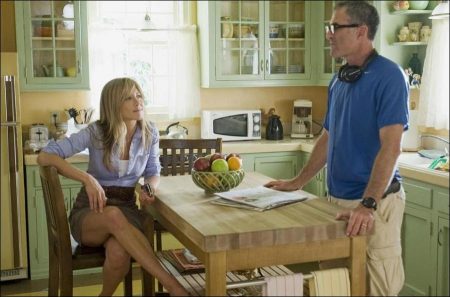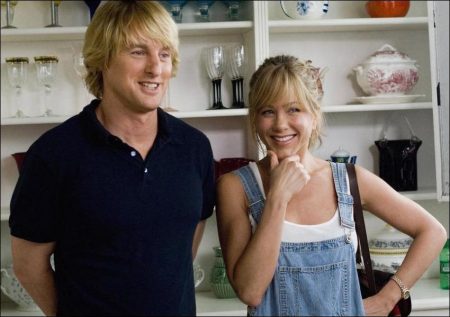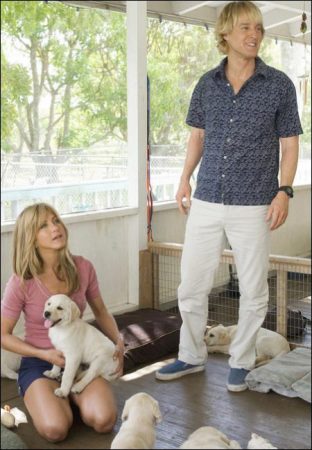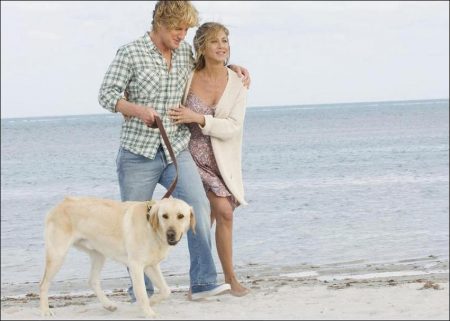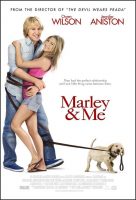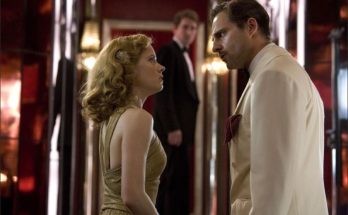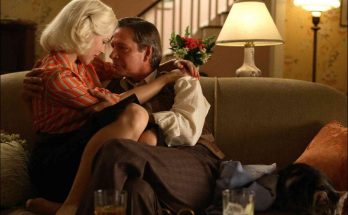Tagline: Their relationship wasn’t going anywhere until one little thing tied it all together.
As the snow falls on their wedding night, newlyweds John and Jenny Grogan (Owen Wilson and Jennifer Aniston) decide to leave behind the harsh winters of Michigan and head south to begin their new lives in West Palm Beach, Florida. They obtain jobs as journalists at competing local newspapers, buy their first home, and begin to make their way through the challenges of a new marriage, new careers and, possibly, the life-changing decision to start a family.
Unsure of his preparedness for raising children, John confesses his fears to his friend and fellow journalist Sebastian, who comes up with the perfect solution: John should get Jenny a puppy. “There’s nothing to it,” says Sebastian. “You walk ’em. You feed ’em, you let ’em out now and then.” Then came Marley.
The Grogans adopt the cute, twelve pound yellow Labrador, who in no time at all, grows into a 100-pound steamroller of unbridled energy that turns the Grogan home into a disaster area. He flunks obedience school, chews off dry-wall, takes a bite out of the sofa, overturns garbage cans, steals a Thanksgiving turkey, consumes pillows and flowers, drinks toilet water, and chases the UPS guy. Even a newly-purchased, expensive necklace isn’t safe from Marley’s voracious antics.
Amidst the mayhem he generates through the years, Marley sees the Grogans through the ups and downs of family life, through job and home changes, and most of all, through the myriad challenges of a growing family. As John and Jenny come to realize, Marley – somehow brings out the best in them.
Fox 2000 Pictures and Regency Enterprises present a Gil Netter / Sunswept Entertainment production, a David Frankel film, starring Owen Wilson and Jennifer Aniston in MARLEY & ME. The comedy also stars Eric Dane and Alan Arkin. It is directed by David Frankel from a screenplay by Scott Frank and Don Roos, based upon the book by John Grogan. The producers are Karen Rosenfelt and Gil Netter. Executive producers are Arnon Milchan and Joe Caracciolo, Jr., the director of photography is Florian Ballhaus, and the production designer is Stuart Wurtzel. The film editor is Mark Livolsi, A.C.E., the music is by Theodore Shapiro, the music supervisor is Julia Michels, and the costume designer is Cindy Evans.
John Grogan’s book Marley & Me and its universal themes of marriage and family resonated to millions of readers, from all walks of life, propelling it to the top of the best-seller charts. “People from all over the world wrote me letters about how the book mirrored their lives,” says the author. “[Those connections were] somewhat accidental; I just stumbled on that. But many people, of course, do fall in love, get married and build families, and that’s what Marley & Me is about.”
While the book and film feature a dog’s name in the title, they tell much more than a story about said canine. “[Marley & Me] is not a dog story,” says Grogan. “When I wrote it, I didn’t think of it as a dog book, and I still don’t. I saw it as a growth-of-afamily story, with the dog being a catalyst. It’s a comedy with a poignant side to it.”
Filmmaker David Frankel, who takes the helm of MARLEY & ME, echoes the author’s sentiments. “The story is about the highs and lows of being young and in love and encountering the challenges of marriage. It also deals with the dreams that get sacrificed for the joys of children, and about the challenges of balancing career and family.
“MARLEY & ME is about marriage, and balancing family and career,” says Jennifer Aniston, who portrays Jenny Grogan. “It’s about all of the things that affect so many people in relationships. You think it’s a story about a mischievous dog – and it is – but it’s so much more than that. There’s something about the Grogans and about Marley that connects in a universal way.”
“It’s about the journey that Marley goes through with the Grogans,” adds Owen Wilson, who plays John Grogan. “Marley reminds them how much fun life can be.”
If MARLEY & ME is not a “dog story,” the titular pooch is certainly a major player in the tail…er…tale. Noting Grogan’s description of Marley being a “catalyst” in the Grogan family dynamic, Frankel points out that “the story tells us how important a dog’s perspective can be to us – and specifically to the Grogans. Dogs are wonderful because they don’t think about the future or the past; they know only the joy of living in the present. And humans, sadly, often forget that.”
The lessons Marley teaches the Grogans are many, and begin even before the pup is adopted by the couple. Adding Marley to their household is intended, at first, as a kind of entryway into the world of parenthood. John is not certain he’s yet up to the task of being a dad, and still envies the freewheeling lifestyle of his unmarried friend Sebastian, played by Eric Dane. “John sees that Sebastian has more professional opportunities,” says Owen Wilson. “Single people’s lives are more fluid. They can take more chances because they have fewer responsibilities and obligations [than married people].”
“Sebastian leads what seems to be an ideal single man’s lifestyle,” says Eric Dane, who stars as Dr. Mark “McSteamy” Sloan on “Grey’s Anatomy.” “Sebastian is always happy to listen to John and give him advice – as long as a beautiful woman and potential conquest doesn’t walk by to distract them.”
“But at the end of the day,” Wilson interjects, “Sebastian is a lonely figure, and there’s a powerful realization for John that he’s made the right choice [to be a family man], and that there’s nothing as strong as the love for, and of, your family.”
John and Sebastian work at the South Florida Sun-Sentinel, another beneficiary of Marley’s “adventures.” Marley provides fodder for the columns John writes for the paper, a fact that doesn’t go unnoticed by his editor, Arnie Klein, played by Oscar®winner Alan Arkin (“Little Miss Sunshine”). The relationship between John and Arnie, an abrasive, old-school newspaperman, is one of respect and concern. John, a reporter at heart, has become a columnist – reluctantly – at Arnie’s behest. “Arnie thinks John is a decent guy – a little confused, but a decent guy,” says Arkin. “Arnie is impressed with John’s writing, including his tales of Marley, but he must reassure John that column writing is what he’s meant to do.”
Chief among Marley’s misadventures chronicled by John is a misguided attempt at taming the leaping Lab through a stint at a local dog obedience school. No dog, John and Jenny are told by the school’s drill-sergeant-like instructor Ms. Kornblut (Kathleen Turner), has ever failed her program. But as Ms. Kornblut learns, there’s always a first time – especially when Marley is involved. Until Marley stormed into and through Kornblut’s class, there was no one – on two legs or four – who could stand up to the trainer’s stern ways. “She’s very no-nonsense,” says Turner of her character. “She insists there are no bad dogs, only bad dog-owners, and she berates the Grogans during the entire class.” That is, until Marley unleashes the full force of his non-obedient ways, and is invited by Ms. Kornblut to exit her school.
The film’s starring cast – indeed the entire production – identified with the film’s themes of love, marriage, family, and a very trouble-prone pooch. David Frankel felt a particularly strong kinship with Grogan’s story. “My family is full of ‘dog people,'” states the director. “We have four amazing dogs that create great moments of laughter for us. Then there are the geographical ties: John lived in South Florida, and I live in Miami.”
Perhaps the strongest autobiographical connection between the filmmaker and his subjects is delineated in a scene from the film. Frankel explains: “Marley has eaten Jenny’s necklace, and Owen as John is in the backyard, looking for the missing jewelry in Marley’s poops. John says, ‘This is just not how I pictured my life, standing in the backyard spraying poop.’ Well, I spend a good part of every day with four dogs in the backyard, spraying poop – and I have that same thought expressed by John.”
Apart from the autobiographical connections, Frankel says much of what made the production special for him was the on-screen chemistry between Owen Wilson and Jennifer Aniston. “That kind of magic is the luck of the draw,” says Frankel. “You put two brilliant movie stars together and they spark in a thrilling way.”
This magic was also apparent to the two stars. “Owen Wilson is just great,” says Aniston. “He’s so good at his job, so professional, and such a generous actor. We had a lot of fun playing off of each other, and he has some moments in the film that are just really special.”
Wilson, in turn, says he had much to admire in Aniston’s performance. “Her instincts were incredible,” says the actor. “She does the work in ways better than I ever imagined.”
Marley & Me Goes to (22) Dogs
W.C. Fields is reputed to have first uttered the immortal line, “Never work with animals or children.” Fields probably would have been fairly miserable on the set of MARLEY & ME, which had a large assortment of animals and kids. But the film’s cast and crew couldn’t have been happier about it. “We had babies, puppies, children, adult dogs, old dogs, kids – and we all had a ball,” Aniston says.
The production utilized 22 dogs to portray Marley, who ages thirteen years in the story. Eleven of the 22 Marleys were puppies, a large number necessitated by the film’s schedule; since MARLEY & ME was shot out of sequence, a puppy used in a given scene would have grown too much to be used again in a scene shot weeks later. Other on-set “Marleys” ranged in age from six months to fourteen years.
Given the age range of the various Marleys, Frankel and head animal trainer Mark Forbes had to carefully map out which dog – at which age – was right for a specific scene. (Approximately 65 percent of the story is set when Marley is 1-6 years old.)
But working with the Marleys was more than charts, graphs and intricate scheduling. It was a production that allowed dogs to be, well, dogs. Mark Forbes elaborates: “We didn’t train our dogs to do anything that a dog wouldn’t naturally do. This film is about a real family who had a real dog. There are no wild tricks or talking animals here.”
Taking the notion a step further, the trainers let Marley be Marley – meaning that since the on-screen character was so rambunctious, it made sense to let the “actors” run wild. “Preparing the dogs [for the film] was almost a kind of anti-training,” notes Forbes. “Usually, we try and create definite behaviors and the dogs are very well trained. With MARLEY & ME, the dogs got to not only be dogs, but the most unruly, untrainable and out-of-control dog in the world. We encouraged bad behavior!”
David Frankel, adamant about letting the dogs be dogs, filmed them even during rehearsals – understanding that their unpredictable behavior could yield the best “take” at any given moment. The main Marley, a dog named Clyde, was predictably unpredictable, just like his cinematic alter-ego, so Frankel elected not to rehearse him at all. “He’s a dog trained to be untrained,” says the director, “and it was exciting to watch him work.”
During the first few weeks of the dogs’ “un-training,” they learned basic commands like how to sit, stand, lie down, and hit their marks. During the next period, the puppies were acclimated to the shooting locations, and the final portion of their prep had them polishing their “skills.” The Marley puppies began their training at the ripe old age of eight weeks, and then filmed until they reached about twelve weeks of age. Then, another batch of Marley pups were brought in for training.
About The Production (2-Legged Version)
The events John Grogan chronicled in his book take place largely in South Florida, where John and Jenny made their first home together, and in Pennsylvania, where the Grogan clan later resided, and where they live to this day. These settings are critical to Grogan’s book and to the film, which shot on location in those two states. “We spent a lot of time trying to find the right location for the right story point,” says production designer Stuart Wurtzel. “David Frankel wanted the film to have a bit of a messy quality; he didn’t want [the locations and sets] to look perfect. John and Jenny’s life is always in flux, always changing.”
John and Jenny begin married life in a starter house in West Palm Beach. As their family grows, the Grogans move to a larger home in Boca Raton. The final move in the story took the production to Philadelphia, as well as to the Pennsylvania countryside and the towns of West Chester, Birmingham Township and Uniondale. “By the time they make the move to Pennsylvania, Marley and the Grogans have grown up together,” says Wurtzel. “John is finally doing the kind of newspaper work he wants to do, Jenny is settled, and Marley has seen them all through the good times and bad.”
To reflect the family’s maturity and growth, Wurtzel wanted the Grogan’s Pennsylvania home to have a warm, solid and inviting feel. The stone farmhouse found by Wurtzel and the production’s locations team in Birmingham Township, so impressed the real John and Jenny Grogan, that the couple decided to purchase a similar home.
The parallels between real and “reel” life for the Grogans didn’t end there. The Grogans make cameos in the film as participants in the obedience school sequence. It was art imitating life – and vice versa – to have the Grogans act in a scene that actually happened in their lives, and to have Owen Wilson and Jennifer Aniston re-enact this memory right in front of the Grogans. “It was a very funny moment – a ‘wake-up’ moment that this movie was really happening,” says John Grogan. “That they were really making a movie about Jenny and me.”
Marley and Me (2008)
Directed by: David Frankel
Starring: Jennifer Aniston, Owen Wilson, Alan Arkin, Eric Dane, Nathan Gamble, Kathleen Turner, Haley Bennett, Ann Dowd, Sarah O’Kelly, Keith Hudson, Ben Hyland, Lucy Merriam, Bryce Robinson
Screenplay by: Scott Frank
Production Design by: Stuart Wurtzel
Cinematography by: Florian Ballhaus
Film Editing by: Mark Livolsi
Costume Design by: Cindy Evans
Set Decoration by: Hilton Rosemarin
Art Direction by: W. Steven Graham
Music by: Theodore Shapiro
MPAA Rating: PG for thematic material, some suggestive content and language.
Distributed by: 20th Century Fox
Release Date: December 25, 2008
Visits: 51
